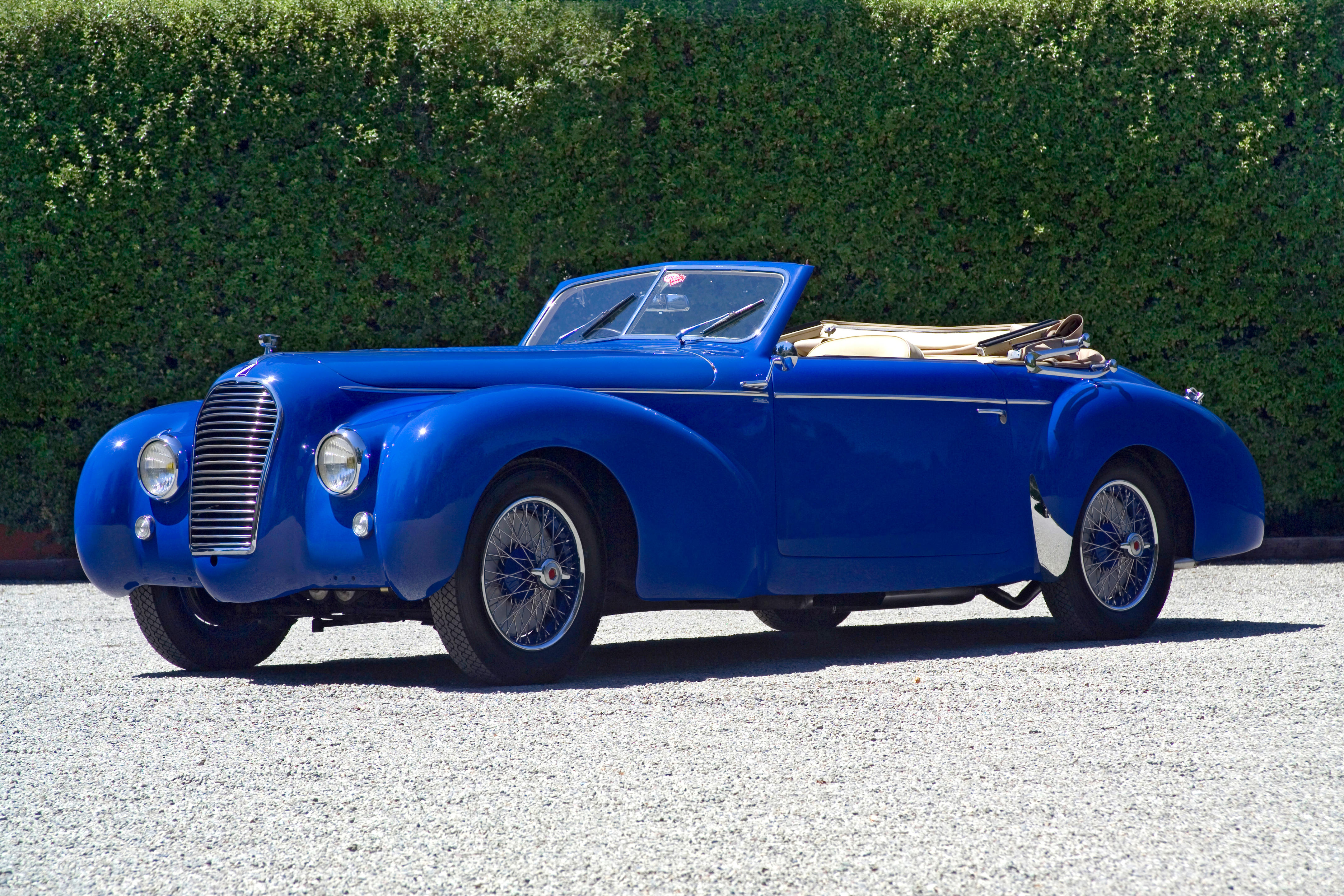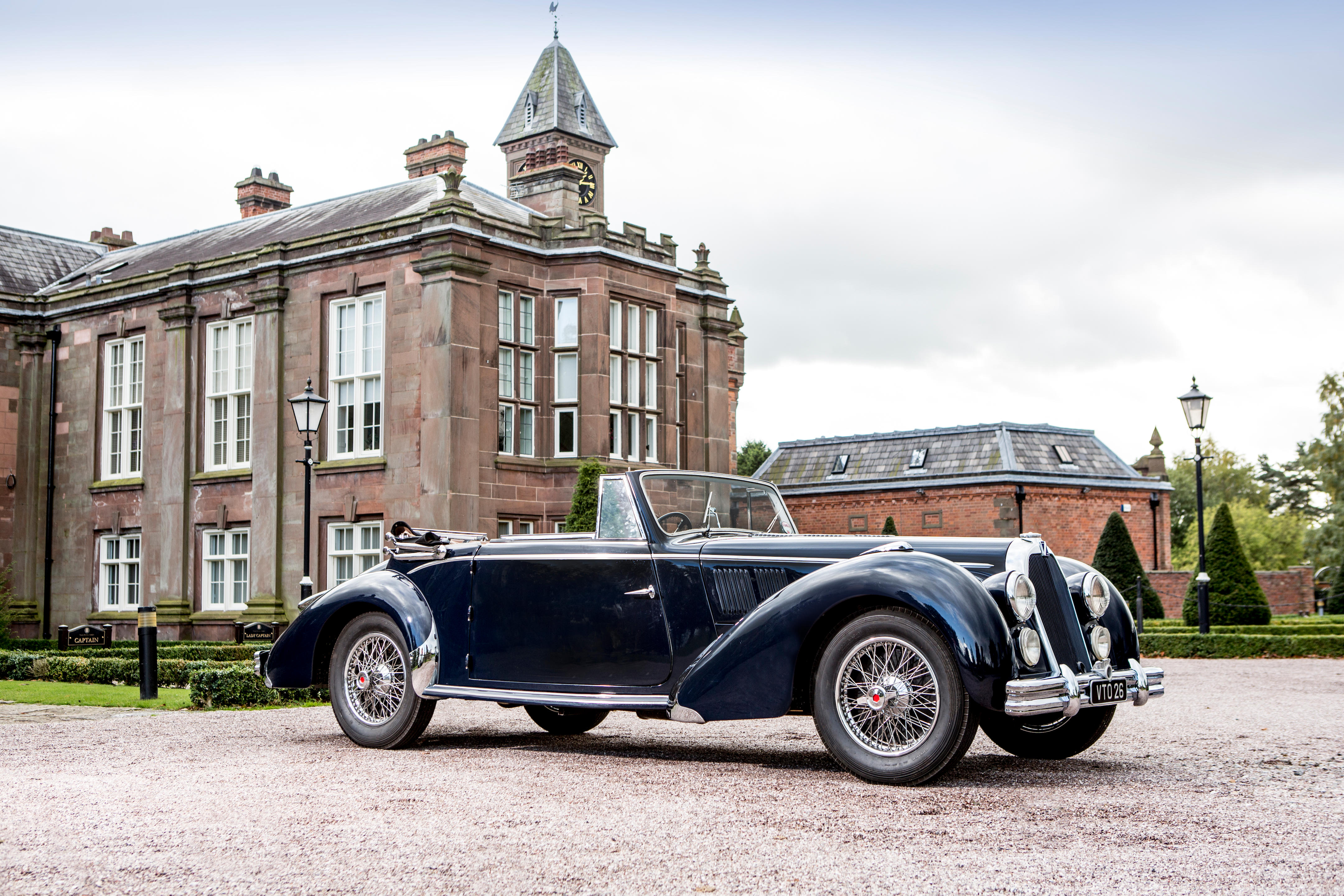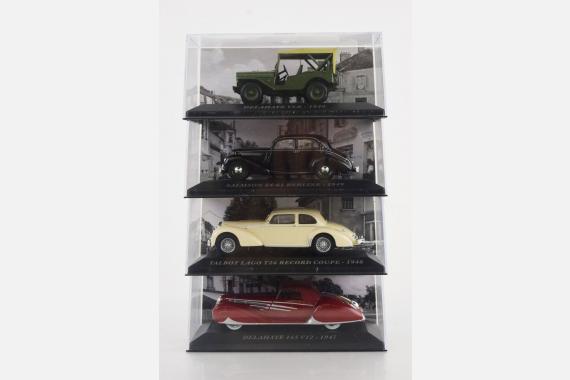The new T26 ‘Lago-Record’ was the world's most powerful production car when it was launched in 1946, with a 4.5-liter engine derived from the company’s robust Grand Prix power unit. It had twin Stromberg EX 32 carburetors, hemispherical combustion chambers with a compression ratio of 7.0:1 (as high as poor quality postwar fuel could cope with), and produced 170 bhp at 4200 rpm. The T26 had twin camshafts mounted high in the cylinder block on either side of the crankshaft centerline. Compared with the previous single-cam design, this configuration lightened the valve gear to give more dependable high-rpm operation. Amazingly, this race-bred chassis could even accommodate a Royal limousine: in 1951 King Ibn Saud of Saudi Arabia took delivery of a massive three-ton long-wheelbase Lago-Record whose equipment included full refrigeration, a lavatory, a washbasin and over half a mile of wiring… But such an assertive statement of power and wealth as the Lago-Record ran counter to the corrosive left-wing politics of the day, which pronounced a death sentence on France’s luxury car builders by introducing a vindictive regime of car taxation. Moreover, Tony Lago’s relentless pursuit of racing success had eaten deep into the company’s cash reserves. But it was in a tone of optimism that the new ‘Record’ had been announced: ‘The new Lago Record 4.5-liter car is the result of many years of experience in motoring and motor car manufacturing by Mr A Lago, the present Chairman of the Company. He gave his name to this car which was made according to his long life ambition: smartness, lightness, fast, easy to drive, in a word: to suit the discriminating sporting motorist.’ The handsome drophead, now strikingly finished in electric blue with cream trim, was delivered in 1949 to one of France’s most famous beverage houses, Marie Brizard of Bordeaux, founded in 1755 when a young woman was given a secret recipe for an ‘extraordinarily fresh and flavored aniseed liqueur’ by a West Indian sailor whose life she had saved. From that beginning, the company grew into a major purveyor of drinks, and in 1949 embarked on a nationwide publicity campaign to promote its range of liqueurs. The car was delivered as a bare chassis with chrome wire wheels to the coachbuilder Dubos of 11 Bis Rue Jean-Jaurès, Puteaux-Seine in the suburbs of Paris. Dubos had its roots in the carriage-building trade, and had come late to the construction of automobile bodywork, producing its first car body in the mid-1920s. Originally based in Neuilly-sur-Seine, Dubos had moved to Puteaux in 1945, and was one of Talbot’s favored suppliers of semi-custom coachwork. Recalled stylist Philippe Charbonneaux, ‘Dubos produced well-finished coachwork and I had the opportunity to design several Delahayes… as well as a Talbot-Lago 4.5 for him.’ Like so many of Tony Lago’s automobiles, the Record was fitted with a four-speed Wilson Pre-selector gearbox in which the epicyclic gear trains were engaged and disengaged by brake bands operated by a pedal occupying the same position as a conventional clutch pedal. The driver manually selected the next brake band to be actuated - and therefore the next gear ratio - with a lever moving in a quadrant on the steering column. Says noted historian Beverley Rae Kimes: ‘The box is less fierce than demanding – it must be treated with respect. Once the car is under way, the lever in any gear can be positioned preparatory, for example, to fast cornering. Nothing will happen until the driver judges that the selected gear should be engaged: then a quick “punch” on the clutch pedal and the engine revs take over. Properly adjusted, therefore, the Wilson was am ideal racing box – and so rugged, so the legend goes, that in the event of brake failure in fast competition, the box could be thrown into reverse, effectively stopping the car without blowing up the box.’ The Record and Grand Sport lines were produced until 1955 despite the hostile environment in which Lago was
The new T26 ‘Lago-Record’ was the world's most powerful production car when it was launched in 1946, with a 4.5-liter engine derived from the company’s robust Grand Prix power unit. It had twin Stromberg EX 32 carburetors, hemispherical combustion chambers with a compression ratio of 7.0:1 (as high as poor quality postwar fuel could cope with), and produced 170 bhp at 4200 rpm. The T26 had twin camshafts mounted high in the cylinder block on either side of the crankshaft centerline. Compared with the previous single-cam design, this configuration lightened the valve gear to give more dependable high-rpm operation. Amazingly, this race-bred chassis could even accommodate a Royal limousine: in 1951 King Ibn Saud of Saudi Arabia took delivery of a massive three-ton long-wheelbase Lago-Record whose equipment included full refrigeration, a lavatory, a washbasin and over half a mile of wiring… But such an assertive statement of power and wealth as the Lago-Record ran counter to the corrosive left-wing politics of the day, which pronounced a death sentence on France’s luxury car builders by introducing a vindictive regime of car taxation. Moreover, Tony Lago’s relentless pursuit of racing success had eaten deep into the company’s cash reserves. But it was in a tone of optimism that the new ‘Record’ had been announced: ‘The new Lago Record 4.5-liter car is the result of many years of experience in motoring and motor car manufacturing by Mr A Lago, the present Chairman of the Company. He gave his name to this car which was made according to his long life ambition: smartness, lightness, fast, easy to drive, in a word: to suit the discriminating sporting motorist.’ The handsome drophead, now strikingly finished in electric blue with cream trim, was delivered in 1949 to one of France’s most famous beverage houses, Marie Brizard of Bordeaux, founded in 1755 when a young woman was given a secret recipe for an ‘extraordinarily fresh and flavored aniseed liqueur’ by a West Indian sailor whose life she had saved. From that beginning, the company grew into a major purveyor of drinks, and in 1949 embarked on a nationwide publicity campaign to promote its range of liqueurs. The car was delivered as a bare chassis with chrome wire wheels to the coachbuilder Dubos of 11 Bis Rue Jean-Jaurès, Puteaux-Seine in the suburbs of Paris. Dubos had its roots in the carriage-building trade, and had come late to the construction of automobile bodywork, producing its first car body in the mid-1920s. Originally based in Neuilly-sur-Seine, Dubos had moved to Puteaux in 1945, and was one of Talbot’s favored suppliers of semi-custom coachwork. Recalled stylist Philippe Charbonneaux, ‘Dubos produced well-finished coachwork and I had the opportunity to design several Delahayes… as well as a Talbot-Lago 4.5 for him.’ Like so many of Tony Lago’s automobiles, the Record was fitted with a four-speed Wilson Pre-selector gearbox in which the epicyclic gear trains were engaged and disengaged by brake bands operated by a pedal occupying the same position as a conventional clutch pedal. The driver manually selected the next brake band to be actuated - and therefore the next gear ratio - with a lever moving in a quadrant on the steering column. Says noted historian Beverley Rae Kimes: ‘The box is less fierce than demanding – it must be treated with respect. Once the car is under way, the lever in any gear can be positioned preparatory, for example, to fast cornering. Nothing will happen until the driver judges that the selected gear should be engaged: then a quick “punch” on the clutch pedal and the engine revs take over. Properly adjusted, therefore, the Wilson was am ideal racing box – and so rugged, so the legend goes, that in the event of brake failure in fast competition, the box could be thrown into reverse, effectively stopping the car without blowing up the box.’ The Record and Grand Sport lines were produced until 1955 despite the hostile environment in which Lago was













Testen Sie LotSearch und seine Premium-Features 7 Tage - ohne Kosten!
Lassen Sie sich automatisch über neue Objekte in kommenden Auktionen benachrichtigen.
Suchauftrag anlegen